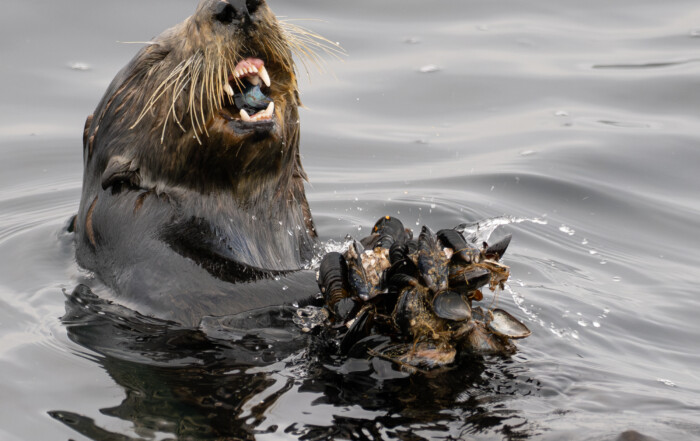** Photographed from a distance, from a pier, w/tele lens and care to not disturb the otter. **
This otter in Monterey Bay was alternately dozing and grooming, while swaddling herself in kelp. I say “herself” because she has the telltale nose scar that female otters incur during mating. I always feel for the females, suffering these painful wounds from male otters who bite the sides of their face or nose.
Here’s a video I shot the same day of the same otter in her napping/grooming routine:
I hadn’t seen this somnambulistic style of fur maintenance, so I reached out to Gena of Sea Otter Savvy to ask about it. I loved her description, and was unaware of these different grooming categories. I’m posting here with her permission:
” … sea otter grooming ranges from very active (somersaults, lateral rolls, bubble blowing) to almost asleep (barely rubbing paws on face, rubbing hind flippers together, etc.). Sea otters will do little bouts of both active and inactive grooming throughout the day and we even have the following choices on our ethogram for data collection: low-intensity grooming and high-intensity grooming. These little movements within a resting bout are probably not dissimilar from our scratching an itch or shifting position while sleeping.”
Photographing sea otters, who were hunted to near extinction for the fur trade, demands a particularly stringent set of field ethics. Sea otters waste a lot of precious survival energy evading human intrusions that can be easily avoided. They are also a threatened species, so it’s critical to understand ethical practices and respectful distances to keep them safe and help them thrive.
I used a 200-800mm equivalent lens (m.zuiko 100-400mm) and silent shutter for these photos. If I see signs of disturbance, I put down my lens and move away. And many times, I just enjoy seeing them on the bay, without taking any photos.
The ideal sea otter photo is usually one where they’re not focused on the photographer or lens. You want them to be going about their business without the stress of human disturbance. Sometimes that does involve looking at the lens, but the sea otter should never be agitated by your presence, or wasting energy escaping you or swimming away.
I’m grateful to Sea Otter Savvy for my learning curve on best practices for sea otter photography. I developed my own set of wildlife field ethics over time, but until I photographed otters, I didn’t understand the special circumstances surrounding their precarious status, and how much human disruption can affect their very survival.
Sea Otter Savvy has comprehensive information and guidelines on responsible sea otter viewing and photography. Be sure to understand these guidelines if you plan to be in Southern sea otter habitat (which is primarily the Central Coast of California).









[…] Source: […]
[…]